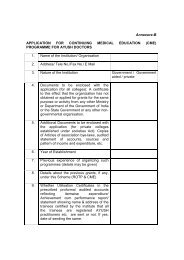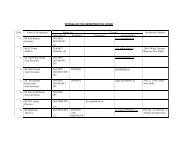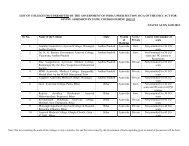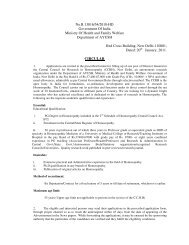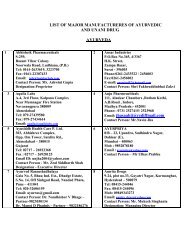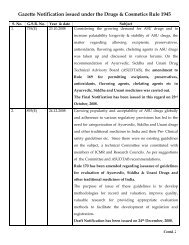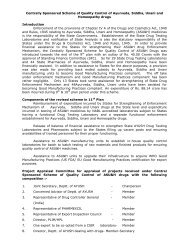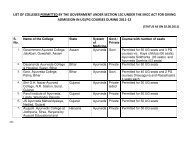<strong>Section</strong> - 4Medical EducationThere had been a paucity <strong>of</strong><strong>AYUSH</strong> colleges in the North-Eastern states and the unionState-wise Distribution <strong>of</strong> Undergraduate Colleges as on 01.04.200723.8%territories, as there had been no<strong>AYUSH</strong> college in the states <strong>of</strong>Manipur, Meghalaya, Mizoram,Nagaland, Sikkim, T ripura,15.0%Andaman & Nicobar Islands,14.0%Dadra & Nagar Haveli, Daman &Diu, Lakshadweep and Puducherry.Apart from this, there were no8.4%Ayurvedic college in the state <strong>of</strong>7.1% 6.5%Arunachal Pradesh and no5.6% 5.6%Homoeopathic graduate college in4.2%the state <strong>of</strong> Jammu & Kashmir.Colleges imparting Unani medicaleducation existed in the states <strong>of</strong>Andhra Pradesh, Bihar, Chhattisgarh,Delhi, Jammu & Kashmir,Karnataka, Madhya Pradesh,Maharashtra, Rajasthan, TamilNadu, Uttar Pradesh and West3.3% 3.3% 3.1%Bengal only. Siddha colleges existed in the states <strong>of</strong> Kerala and Tamil Nadu only. Medical education inNaturopathy were being imparted in the states <strong>of</strong> Andhra Pradesh, Chhattisgarh, Gujarat, Karnatakaand Tamil Nadu.MaharashtraKarnatakaMadhya PradeshAverage annual growth rate <strong>of</strong> 4.5% was registered in 2007 over 1992 in colleges impartingunder graduate education and their admission capacity had grown by 7.5%. Maximum <strong>of</strong> 13.8%annual growth was observed in 1994 in <strong>AYUSH</strong> colleges while maximum <strong>of</strong> 26% annual growth wasobserved in admission capacity <strong>of</strong> total colleges in 2000. Average annual growth rates <strong>of</strong> 5.4%, 2.7%,8.7%, 3.7% and 8.4% had been attained in Ayurveda, Unani, Siddha, Homoeopathy and Naturopathycolleges respectively during 1992-2007, while the admission capacities under these systems hadgrown annually by 6.6%, 5%, 5.8%, 8.8% and 12% respectively. The maximum annual growth rates<strong>of</strong> 21.1%, 19.4%, 30.4% and 66.7% were realised in the number <strong>of</strong> colleges <strong>of</strong> Ayurveda, Unani,Homoeopathy and Naturopathy in 1993, 2000, 1994 and 1998 respectively. Siddha collegesaugmented 2.5 times in the year 2002 over 2001. Maximum annual growth rates <strong>of</strong> 20.4%, 25.3%,60% and 41.6% were realised in the admission capacities <strong>of</strong> colleges <strong>of</strong> Ayurveda, Unani, Siddha andHomoeopathy in 2003, 1996, 2002 and 2000 respectively. Admission capacity <strong>of</strong> Naturopathycolleges increased 2.3 times in 1998 over 1997.Admission capacity had increased significantly (more than one and half times) over the period1992 to 2007, with an average admission capacity <strong>of</strong> 37.4 per college in 1992, it had gone up to 56.6per college in 2007. An increasing trend had been observed in the admission capacity <strong>of</strong> Ayurveda, asaverage admission capacity for Ayurveda colleges had increased from 39.6 in 1992 to 46.8 per collegein 2007. Similar trend had been observed in the intake capacity <strong>of</strong> Unani colleges, which is up from32.5 in 1992 to 44.9 in 2007. Similarly, the average admission capacities <strong>of</strong> Homoeopathy andNaturopathy colleges had increased from 36 and 23.3 in 1992 to 73.4 and 38.5 in 2007 respectively.However, the average admission capacity <strong>of</strong> Siddha colleges had gone down from 75 in 1992 to 50 in2007. The maximum intake capacity <strong>of</strong> 56.6 per <strong>AYUSH</strong> college was realised during the year 2007.The maximum intake capacities <strong>of</strong> Ayurveda, Unani and Homoeopathy colleges were observed in2007, whereas, the maximum intake capacities <strong>of</strong> 77.5 per Siddha college and 38.5 per Naturopathycollege were observed during the periods 1993-1997 and 2005-2007 respectively.Uttar PradeshBiharGujaratTamil NaduKeralaPunjabWest BengalRajasthanOther States84 <strong>AYUSH</strong> IN INDIA 2007
Medical Education <strong>Section</strong> - 4States and unionterritories having higher(greater than equal to65%) average admissioncapacities for all the<strong>AYUSH</strong> colleges in 2007were Gujarat, HimachalPradesh, Madhya Pradesh,Maharashtra andChandigarh, whereas,states with low (less than40%) average admissioncapacities in 2007 wereOrissa, Jammu & Kashmirand Assam. The state<strong>of</strong> Jammu & KashmirMaharashtraKarnatakaMadhya PradeshUttar PradeshBiharGujaratTamil NaduKeralaPunjabWest BengalRajasthanOther StatesAverage Admission capacities <strong>of</strong> States having majority <strong>of</strong>undergraduate colleges as on 01.04.2007had the maximum average admission capacity <strong>of</strong> 60 students per college and Bihar had minimumaverage admission capacity <strong>of</strong> 30 students per college in Ayurveda in 2007. The state <strong>of</strong> AndhraPradesh had the maximum average admission capacity <strong>of</strong> 62.5 students per Unani college, andJammu & Kashmir had the minimum average admission capacity <strong>of</strong> 20 students per Unani college in2007. Maximum intake capacity <strong>of</strong> 105.7 students per college was observed in the State <strong>of</strong> Gujaratunder Homoeopathy, whereas the minimum <strong>of</strong> 30 students per college was registered in Assam. Thestates <strong>of</strong> Tamil Nadu and Kerala had the same intake capacity <strong>of</strong> 50 students per college underSiddha system. The state <strong>of</strong> Gujarat had the maximum average admission capacity <strong>of</strong> 50, whileAndhra Pradesh has the minimum <strong>of</strong> 30 students per college in Naturopathy.45.746.546.650.149.053.955.060.661.765.465.878.5(b) Post Graduate Education:Post Graduate educationhad been introduced in anumber <strong>of</strong> existing <strong>AYUSH</strong>colleges since the creation <strong>of</strong> aseparate <strong>Department</strong> <strong>of</strong> IndianSystems <strong>of</strong> Medicine andHomoeopathy in 1995. As on01.04.2007, there were 105colleges with admission capacity<strong>of</strong> 2252 students imparting postgraduate education in India. Out<strong>of</strong> which, 41% colleges with35.6% admission capacitypertain to Government sector.59.0%System-wise Percentage Distribution <strong>of</strong> postgraduate collegesand their admission capacities as on 01.04.200744.0%31.4%48.1%Ayurveda Homoeopathy Unani Siddha6.7%3.0%Number <strong>of</strong> InstitutionsAdmission Capacity59% <strong>of</strong> total post graduate colleges with 44% <strong>of</strong> admission capacity were <strong>of</strong> Ayurveda whereas 31.4%colleges with 48.1% admission capacity belonged to Homoeopathy. Only 9.5% <strong>of</strong> the post graduatecolleges with 7.9% admission capacity belonged to other systems <strong>of</strong> <strong>AYUSH</strong>.2.9%4.9%Out <strong>of</strong> all medical colleges imparting post graduate <strong>AYUSH</strong> education, six colleges withadmission capacity <strong>of</strong> 197 students were exclusively post graduate institutions. One exclusive postgraduate college each <strong>of</strong> Unani and Siddha systems with admission capacities <strong>of</strong> 28 and 30 existed in<strong>AYUSH</strong> IN INDIA 2007 85




